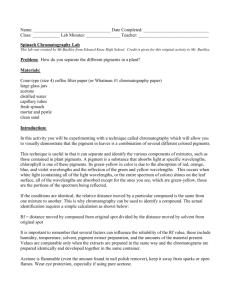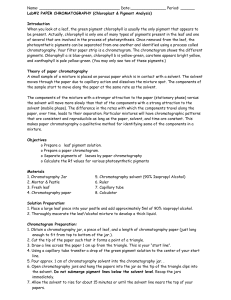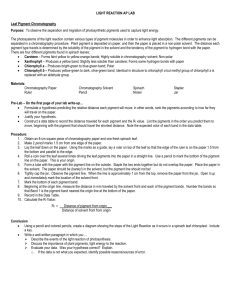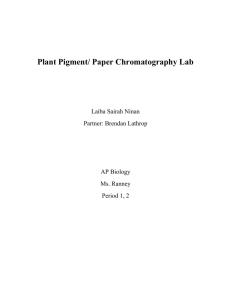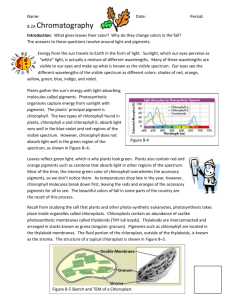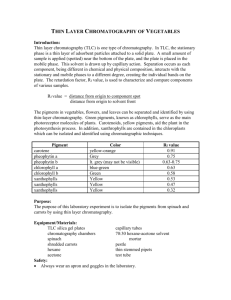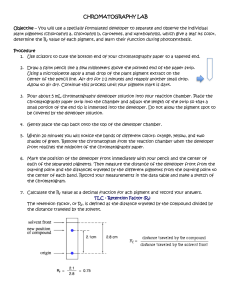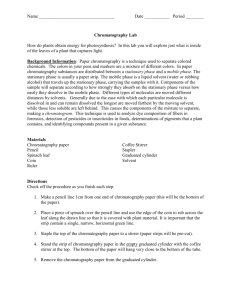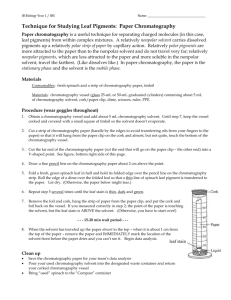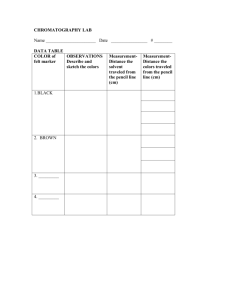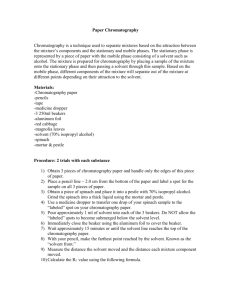Theory of paper chromatography
advertisement
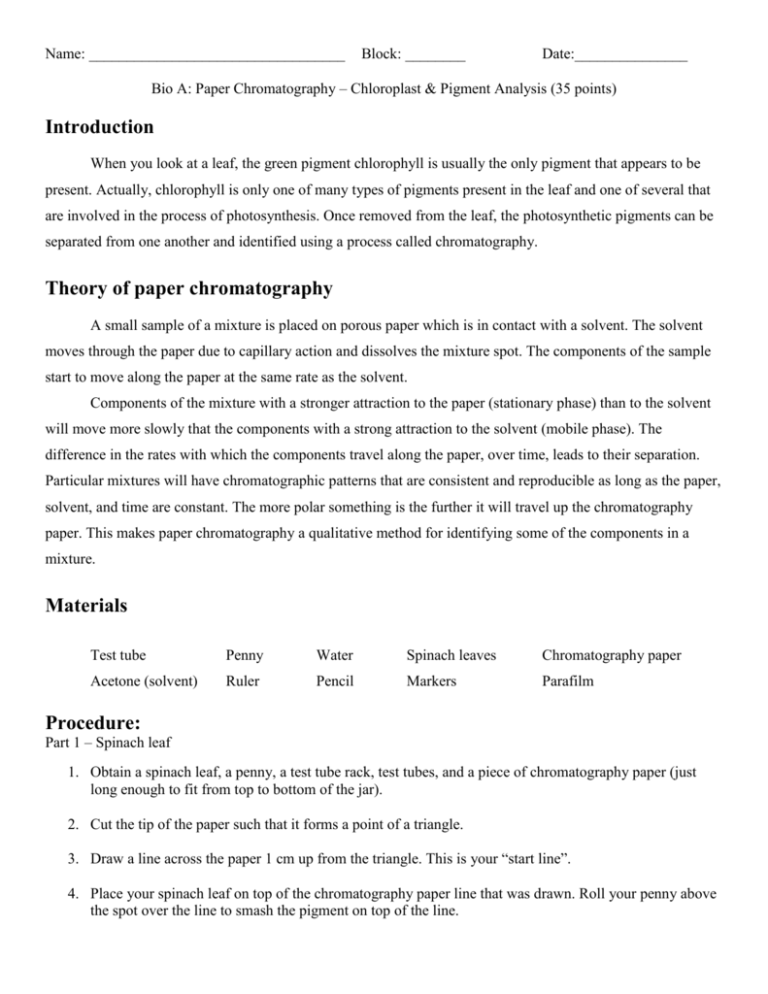
Name: __________________________________ Block: ________ Date:_______________ Bio A: Paper Chromatography – Chloroplast & Pigment Analysis (35 points) Introduction When you look at a leaf, the green pigment chlorophyll is usually the only pigment that appears to be present. Actually, chlorophyll is only one of many types of pigments present in the leaf and one of several that are involved in the process of photosynthesis. Once removed from the leaf, the photosynthetic pigments can be separated from one another and identified using a process called chromatography. Theory of paper chromatography A small sample of a mixture is placed on porous paper which is in contact with a solvent. The solvent moves through the paper due to capillary action and dissolves the mixture spot. The components of the sample start to move along the paper at the same rate as the solvent. Components of the mixture with a stronger attraction to the paper (stationary phase) than to the solvent will move more slowly that the components with a strong attraction to the solvent (mobile phase). The difference in the rates with which the components travel along the paper, over time, leads to their separation. Particular mixtures will have chromatographic patterns that are consistent and reproducible as long as the paper, solvent, and time are constant. The more polar something is the further it will travel up the chromatography paper. This makes paper chromatography a qualitative method for identifying some of the components in a mixture. Materials Test tube Penny Water Spinach leaves Chromatography paper Acetone (solvent) Ruler Pencil Markers Parafilm Procedure: Part 1 – Spinach leaf 1. Obtain a spinach leaf, a penny, a test tube rack, test tubes, and a piece of chromatography paper (just long enough to fit from top to bottom of the jar). 2. Cut the tip of the paper such that it forms a point of a triangle. 3. Draw a line across the paper 1 cm up from the triangle. This is your “start line”. 4. Place your spinach leaf on top of the chromatography paper line that was drawn. Roll your penny above the spot over the line to smash the pigment on top of the line. 5. Pour approx. 1 cm of chromatography solvent (acetone) into the chromatography jar. 6. Place the chromatography paper with the pigment into a test tube so the tip of the triangle dips into the solvent (acetone). Do not submerge pigment lines below the solvent level. Obtain a piece of parafilm and tightly cover the test tube. Place it into the test tube rack. 7. Allow the solvent (acetone) to rise for about 15 minutes or until the solvent line nears the top of your papers. 8. Some possible colors and the pigments they represent are: o Faint yellow – carotene o Yellow – xanthophyll o Bright green – chlorophyll a o Yellow-green – chlorophyll b o Red – anthocyanin 9. Measure the distance from the start point to the front line and each of the pigment lines. Record these measurements in the data table. Calculate the Rf values for each pigment according to the following formula: Part 2 – Marker colors 1. Perform the same task except with a scented black marker instead of a spinach leaf. Place a dot with scented black marker on the drawn pencil line. Use water instead of acetone. 2. Repeat this again for another color marker of your choice. Use water instead of acetone. (5 points) 1. Draw the piece of chromatography paper when it is done below (3 drawings): (6 points) Spinach Leaf Black Sharpie Marker Other Color Marker 2. Describe the results of the chromatography tests in words for each of the 3 tests. (3 points) Spinach Leaf Black Sharpie Marker Other Color Marker Analysis & Conclusions: 1. What is chromatography? What does it tell you? (3 points) __________________________________________________________________________________________ __________________________________________________________________________________________ __________________________________________________________________________________________ __________________________________________________________________________________________ __________________________________________________________________________________________ 2. What pigments did you see in the spinach leaf? How did you know? (3 points) __________________________________________________________________________________________ __________________________________________________________________________________________ __________________________________________________________________________________________ __________________________________________________________________________________________ __________________________________________________________________________________________ 3. Which of these pigments from the spinach leaf would be considered the most polar? Which one would be the least polar? How do you know? (3 points) __________________________________________________________________________________________ __________________________________________________________________________________________ __________________________________________________________________________________________ __________________________________________________________________________________________ __________________________________________________________________________________________ __________________________________________________________________________________________ __________________________________________________________________________________________ 4. Explain 1 use for 3 different pigments that would be found in a plant. (3 points) __________________________________________________________________________________________ __________________________________________________________________________________________ __________________________________________________________________________________________ __________________________________________________________________________________________ __________________________________________________________________________________________ __________________________________________________________________________________________ __________________________________________________________________________________________ 5. What would happen if the plant was missing its carotenoids? Why would that occur? [Hint: Think about what the job of those pigments is] (3 points) __________________________________________________________________________________________ __________________________________________________________________________________________ __________________________________________________________________________________________ __________________________________________________________________________________________ __________________________________________________________________________________________ __________________________________________________________________________________________ __________________________________________________________________________________________ 6. Many trees have leaves that are green in the summer and red, yellow, or orange in autumn. Where were these colors during the summer? Why did they suddenly appear in autumn? (3 points) __________________________________________________________________________________________ __________________________________________________________________________________________ __________________________________________________________________________________________ __________________________________________________________________________________________ __________________________________________________________________________________________ __________________________________________________________________________________________ 7. Explain 1 similarity and 2 differences between your three results (spinach leaf, black sharpie and other colored sharpie). (3 points) __________________________________________________________________________________________ __________________________________________________________________________________________ __________________________________________________________________________________________ __________________________________________________________________________________________ __________________________________________________________________________________________ __________________________________________________________________________________________ __________________________________________________________________________________________ __________________________________________________________________________________________ Chlorophyll Fluorescence INTRODUCTION When a pigment absorbs light, electrons of certain atoms in the pigment molecules are boosted to a higher energy level. The energy of an absorbed and a photon is converted to the potential energy of the electron that has been raised to an excited state. In most pigments, the excited electron drops back to its ground-state, or normal orbit, and releases the excess energy as heat. Some pigments, including chlorophyll, emit light as well as heat after absorbing photons. In the chloroplast, these excited electrons jump from the chlorophyll molecule to a protein molecule in the thylakoid membrane, and are replaced by electrons from the splitting of water. The energy thus transferred, is used in carbohydrate production. This release of light is called fluorescence. Chlorophyll will fluoresce in the red part of the spectrum, and also give off heat. In this lab, you will observe this fluorescence by separating the chlorophyll from the thylakoid membrane. MATERIALS Spinach leaves Flashlight or small lab light Mortar and pestle Test tube Acetone Filter paper 25-mL graduated cylinder Funnel Ring stand or funnel rack Safety goggles PROCEDURE 1. Grind the spinach leaves using a mortar and pestle. 2. Add acetone to the ground leaves, using enough acetone and spinach leaves to get between 10 and 15 mL of extract. 3. Set up your filtering apparatus, and using proper filtering technique, filter the extract to a test tube. NOTE: Use a small amount of acetone to wet the filter paper, to hold it into place, instead of water. 4. Shine a flashlight, or other similar light source, through the test tube and extract. 5. Observe the fluorescence of the chlorophyll at a 90 degree angle to the flashlight. Analysis Questions: 1. What color is chlorophyll when you shine a light on it? Why would it be that color? 2. Why do you need to grind up the spinach leaves for this experiment? 3. This chlorophyll is involved in what important plant process? 4. If the chlorophyll were to be removed from these leaves, what possible colors could be shown? Why would this occur?

